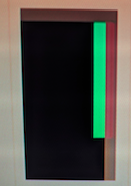How to Play
It's Snake. You know how to play it. Use the cursor keys or WASD to change snake direction. Press p to pause.
How to Run
Open up snake.tomislav.io and give it a shot.
Alternatively, you could get it from github here: https://github.com/tomca32/snake
git clone git@github.com:tomca32/snake.git
cd snake
yarn # or npm install
yarn run build # or npm run build
open dist/index.htmlif you got this as a part of the zip package, then it should be prebuilt and you can just open the dist/index.html file.
Running yarn run dev will start the development mode which will watch files and recompile and won't minify.
Features
- Snake
- Food
- Walls
- Fully responsive, works on any screen size (you still need to have the keyboard though)
- Adjustable speed - use the buttons in the top-left corner
- Adjustable grid size (restarts the game) - use the buttons in the top-right corner
- Pause - press
p - Immediate restart on death
Lessons Learned
Green and grey tiles next to each other cause optical illusions on a crappy screen with f.lux enabled
In the above image, when f.lux is enabled, and you have a crappy screen, it looks like the wall next to the green snake is redish in hue. I was certain this was a rendering bug somewhere. It's not; it's an optical illusion, or a f.lux artifact. The wall is grey.
I don't want to admit how much time I wasted on this.
Determining direction from user input is complex
Snake sounds like a pretty simple game, and it is. The user input is also pretty simple, 4 keys, 4 directions. Snake goes in the direction that was pressed, except it can't go backwards. While this is true, it's also much simplified view and the complexity becomes apparent when we start thinking about time. Let's say that one step of our snake game takes 100ms and think about what the user does.
Here is a happy path:
- Snake is moving to the right
- User presses the
upkey at 90ms since the start of the frame - 10ms later, a new frame starts and snake moves one tile up
- 10 ms later, user presses the
rightkey - 90 ms later, a new frame starts and snake changes direction to the right
So far so good, now let's take a look at a bit unhappier path:
- Snake is moving to the right
- User presses the
upkey 30ms since the start of the frame - 20ms later, user presses the
rightkey - Snake never changed directions and just kept on moving to the right
In both cases, the user did exactly the same thing, they pressed two keys in rapid succession, 20 ms apart and the snake behaved differently. This makes for a clunky and confusing experience. We cannot have users doing the same actions but having different results.
The solution is to enable queuing up the following direction change even if the current one didn't execute yet. This complicates code a bit but makes for a much better UX.
Unit Test Movement Logic
Should have done TDD on the movement logic. I managed to, accidentally, break it many. many times. That logic is a perfect candidate for unit testing since it's mostly just pure functions.
Things to add or improve on
Improve the UI
There is really no UI at the moment. If we want to have speed options, map size options, and other ideas listed below, there needs to be a more coherent UI than just a couple of buttons thrown in the corners.
Map Editor
There is a potential for the map editor here. Maps could be encoded in text, or even simpler, just a set of coordinates where the walls are located. That can be parsed and initialized by the grid module. I have done something similar in my Pacman game which you can find here: https://github.com/tomca32/pacman
Replays
It shouldn't be too difficult to keep a history of the snake's movement. We already keep a previous movement direction on every step in the input module; this can be changed to an array and just keep pushing directions into it on every step thus giving us a history of the snake's movement.
Scoring System
Some sort of scoring system. Simplest idea is to just keep track of the food eaten. It might make sense to take game speed into account here.
Rendering Optimization
Current rendering code is a nested loop that goes through all the tiles and rerenders them on each frame. This is O(n^2), where n is map surface area, and can be slow on large maps. Snake is a simple enough game for this to be unnoticeable but it can still be improved.
Multiplayer
Crazy idea, but multiplayer deathmatch would be cool. Multiple snakes on the same field battling for dominance and trying to trap each other with their bodies. Two ways to win, be the largest snake before the timer expires, say 5 minutes, or be the last snake standing/crawling.
Prebuilt maps
Snakes on a plane!
Teleporter Tiles
Tiles that transport whatever is onto them into some other tile. Better have quick reflexes if the exit tile is right next to a wall. For bonus excitement in multiplayer, make the exit tile change after every use.
Other devices
Make it work on touchscreen, maybe listen to swipe directions or touches at the edge of the screen.

